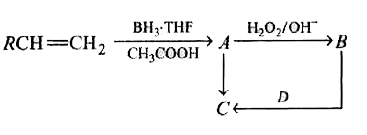The mechanism of the reaction : A+B →C is as under: A → D [slow], D → C [fast]. Choose the set showing rate equation and order with respect to A and B :
k1[A],(1,0)
k1[A]2,(0,1)
k1[A][B],(2,0)
k1[A]2,(2,0)
The correct Answer is:A
To solve the problem regarding the mechanism of the reaction A + B → C, we need to analyze the given steps of the reaction and determine the rate equation and the order with respect to A and B.
1. Identify the Steps of the Reaction Mechanism:
- The reaction mechanism is given as:
- Step 1: A → D (slow step)
- Step 2: D → C (fast step)
2. Determine the Rate-Determining Step:
- The slow step (A → D) is the rate-determining step (RDS). The rate of the overall reaction is determined by this step.
3. Write the Rate Law:
- The rate law is based on the rate-determining step. Since the slow step involves only reactant A, we can express the rate as:
Rate=k(A)n
- Here, n is the order with respect to A.
4. Determine the Order with Respect to A:
- From the stoichiometry of the slow step, the coefficient of A is 1. Therefore, the order with respect to A is:
n=1
- Thus, the rate law becomes:
Rate=k(A)1
5. Determine the Order with Respect to B:
- The concentration of B does not appear in the rate law because it is not involved in the rate-determining step. Therefore, the order with respect to B is:
0
6. Final Rate Equation and Orders:
- The final rate equation is:
Rate=k(A)1
- The order with respect to A is 1, and the order with respect to B is 0.
Conclusion:
- The correct set showing the rate equation and the order with respect to A and B is:
- Rate equation: Rate = k(A)
- Order with respect to A: 1
- Order with respect to B: 0
- The reaction mechanism is given as:
- Step 1: A → D (slow step)
- Step 2: D → C (fast step)
- The slow step (A → D) is the rate-determining step (RDS). The rate of the overall reaction is determined by this step.
- The rate law is based on the rate-determining step. Since the slow step involves only reactant A, we can express the rate as:
Rate=k(A)n
- Here, n is the order with respect to A.
- From the stoichiometry of the slow step, the coefficient of A is 1. Therefore, the order with respect to A is:
n=1
- Thus, the rate law becomes:
Rate=k(A)1
- The concentration of B does not appear in the rate law because it is not involved in the rate-determining step. Therefore, the order with respect to B is:
0
- The final rate equation is:
Rate=k(A)1
- The order with respect to A is 1, and the order with respect to B is 0.
- The correct set showing the rate equation and the order with respect to A and B is:
- Rate equation: Rate = k(A)
- Order with respect to A: 1
- Order with respect to B: 0
Similar Questions
Knowledge Check

In this sequence of reaction A, B, C and D are respectively :A(RCH2CH2)3,B,RCH2CH2OH,RCH2CH3,HIB(RCH2CH2)3B,RC∣OHHCH3,RCH2CH3,HIC(RCH2CH3)3B,RCH∣OH−CH2CH3,RCH2CH3,HIDnone of the above
The reaction A+B → C has zero order. What is the rate equation?
View SolutionThe reaction A+B→C has zero order. What is the rate equation?
View SolutionThe reaction A+B→C has zero order. What is the rate equation?
View SolutionThe reaction A+B → C. has zero order. What is the rate equation?
View SolutionIf reaction between A and B to give C shows first order kinetics in A and second order in B, the rate equation can be written as
View SolutionThe reaction A+B→C has zero order. Write rate equation.
View SolutionThe reaction A+B→C has zero order. Write rate equation.
View Solution
